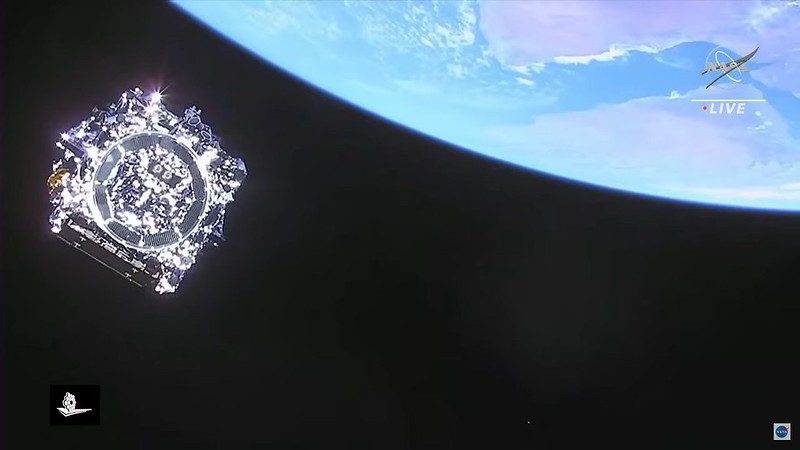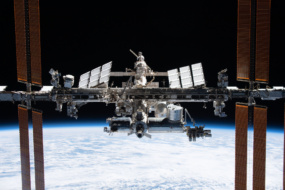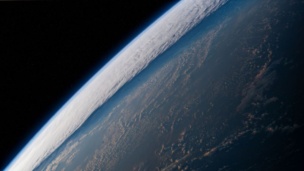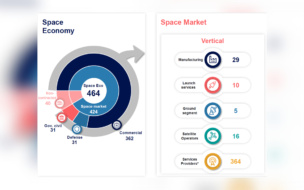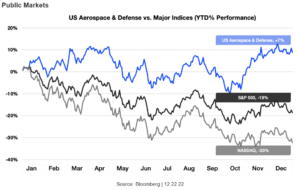Right now, a $10 billion space telescope is orbiting an empty point in space a million miles from home where the gravitational forces of the Earth and Sun balance out. The observatory, which took some of the world’s best engineers and scientists more than 20 years to build, is gearing up to take its first look out into the universe, observing the atmospheres of exoplanets, the chemical makeup of distant galaxies, and the formation of stars and galaxies as far back in time as we’ve ever been able to observe, close to the Big Bang.
The James Webb Space Telescope—JWST for short—is ready to change the way we view the universe. And ground control just turned its instruments on.
Any way you slice it, JWST is a marvel of technology and human innovation. But if you ask us, the international coordination required to will new technologies into reality—and then integrate the brand-new inventions into the craft—might be the most mind-boggling part.
We wanted to hear a mini oral history of what it took to create JWST—and those who spent decades of their lives working on the space observatory. So, we dialed up Paul Geithner, NASA’s deputy project manager for the technical portion of JWST development. In the paragraphs that follow, you’ll hear from Geithner about the new technologies developed for JWST, its four onboard instruments, and the coordination costs involved with a decades-long international project.
Beginning the Build
The engineering, Geithner explained, begins with the science requirements.
In the late 90s, when JWST was just a twinkle in astronomers’ eyes, scientists and engineers from NASA, ESA, and the Canadian Space Agency (CSA) discussed the science requirements, debating on a large scale what capabilities this telescope needed to make the project worth it. The telescope needed to peer into galaxies 13 billion light years away; it needed to produce images with high resolution and low noise; it needed a spectrograph that could observe 100 objects at once; it needed a steering mechanism; and it needed to observe a wide enough spectrum of infrared and near-infrared light.
These science needs led to technical requirements. To see as far as scientists had ambitiously envisioned, the telescope’s primary mirror needed to be 6.5 meters across. One issue: a solid mirror of that size would be too large to fit in a rocket fairing and launch into orbit. JWST’s segmented mirrors “were an example of technology that really didn’t exist” outside of ground telescopes, Geithner said. The beryllium-and-gold composition made the mirrors light enough to get off the ground.
When NASA and its partner agencies were hashing out the planned technical capabilities of JWST, “the first concepts of this were basically a four channel near-Infrared camera,” Geithner said. “That was way back in the day, because that was kind of the minimum you needed.”
Each agency wanted a piece of the pie when it came to JWST real estate, and (eventually) observation time on the telescope. The agencies settled on creating a module that would hold instruments developed by each partner agency, widening the scope of the scientific endeavors that could be supported by JWST.
“I think we did it right,” Geithner said. “Everybody gets way more than they would get on their own.”
Then began development. But how do you build technology that doesn’t exist yet? “Well, you find the smartest technology-development people you’ve got, and you just go in the lab, and you work, and you figure it out,” Geithner said. No problem.
The Instrument Rundown
There are four instruments on JWST, each focused on gathering a different type of data for scientists back home to analyze:
- Near-Infrared Camera (NIRCam), developed by the University of Arizona
- Near-Infrared Spectrograph (NIRSpec), developed by ESA and NASA/Goddard Space Flight Center
- Mid-Infrared Instrument (MIRI), developed by the European Consortium with ESA
- Fine Guidance Sensor/Near Infrared Imager and Slitless Spectrograph (FGS/NIRISS), developed by CSA.
NIRCam
Of JWST’s four instruments, NIRCam may be most familiar to the casual observer. The imager will survey light wavelengths between 0.6 and five microns—wavelengths just slightly longer than those of visible light—and will produce high-resolution, low-noise images for scientists back on Earth to analyze.
“The trick with NIRCam was really good optical performance over a relatively wide field of view,” Geithner said. “The detectors themselves had to be so good that we’re not limited by the noise provided by detectors or a thermal background provided by the telescope.”
NASA chose University of Arizona’s near-infrared imager design proposal, Geithner said, because of its compact design. Rather than using entirely reflective elements, the imager also uses refraction elements made of different kinds of salt. This allowed for a compact form factor, but came at a price: The instrument was fragile and tricky to build. Therein lies the tradeoff: Building the imager came with extra headaches, but the development troubles ultimately led to higher performance levels and less noise.
NIRCam also has a dual purpose in addition to its imaging capabilities. “When we first turn NIRCam on, it’s going to basically see 18 images of the same star, one from each mirror segment in the primary mirror,” Geithner explained.
“We’ve got to turn those into one unaberrated image of the star where all the mirrors are working together. So NIRCam fills that role—it’s not just a big imager for science. It’s also the camera we use to tune up the telescope. So it’s got an engineering purpose, not just a science purpose.”
NIRSpec
While NIRCam and NIRSpec will observe the same region of light wavelengths, NIRSpec is responsible for collecting an entirely different type of data: spectral content, which can be analyzed for chemical makeup, speed, and direction. “It’s like putting a light through a prism,” Geithner said. “A prism will spread the light out into its constituent colors. That’s what a spectrograph does—it takes light and it spreads it out so you can see the spectral content of the light.”
And instead of taking a wide field-of-view image of a cross-section of space, the spectrograph will focus on specific structures. It uses a tool developed by NASA’s Goddard Space Flight Center: the programmable microshutter array. It’s a flat panel filled with tiny, 100-200 micron diameter holes. NIRSpec can be programmed to cover certain regions of those holes in order to isolate a desired object within the telescope’s field of view and gather more precise information about it.
NIRSpec is made almost entirely out of a material called silicon carbide. “It’s basically fine china,” Geithner said. Building the entire instrument out of this material attacked the problem of how to build something at room temperature that still works at cryogenic temperatures—it means that as the instrument shrinks from the cold, it shrinks fairly uniformly and will still work as expected.
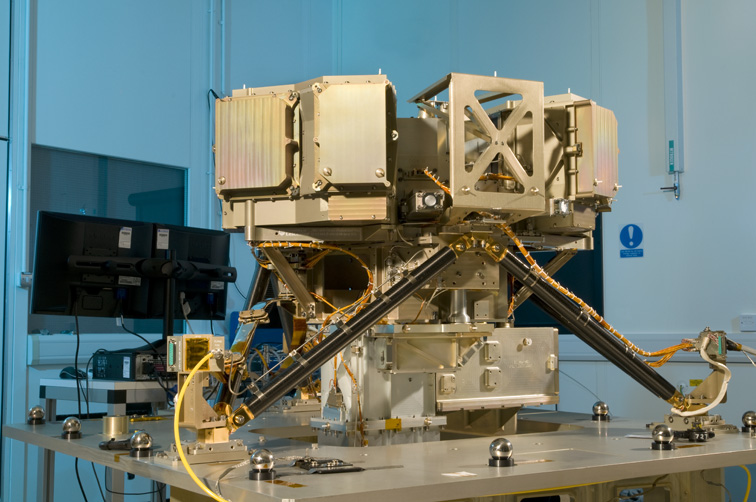
MIRI
MIRI, or mid-infrared instrument, will observe a different band of light wavelengths than the other instruments—between five and 28 microns.
MIRI is a case study in technology that solves a problem that, at the time of its development, did not exist. “When Webb was first conceived, scientists thought that the first stars and galaxies formed at less of a redshift than we know they must have today,” Geithner explained. “And so having that infrared coverage, deeper into the mid-infrared, means that there are some important observations of important characteristics that we need that extended spectral coverage to have when we make observations.”
And the instrument came with its own technical challenges. While the telescoping instruments on JWST are able to reach cool enough temperatures just by being behind the high-performing, 70-foot sunshield, MIRI needs to reach an even lower temperature—less than 7 Kelvin—to suppress infrared noise. That means it needed an active cooling system. “That adds a lot of cost and complexity,” Geithner said. As JWST engineers decided at the early end of the project, “it’s probably worth it.”
Ultimately, the space agencies developed a cryocooler for MIRI. The cooler lives in the spacecraft and runs on a closed helium cooling system, shuttling super-cold helium through gold-plated steel tubes back and forth from MIRI ~10 meters away. Because the cooler is a closed loop, it will never run out of fuel, and is only limited in its longevity by wear and tear on its two opposing pistons.
FGS/NIRISS
The last instrument in JWST’s instrument module serves a dual purpose. FGS, or Fine Guidance Sensor, is a near-infrared camera that locks onto a guide star to stabilize the telescope while an observer is looking at a specific science target. These sensors will be used exclusively for fine steering and calibrating images (unlike the fine guidance sensors on Hubble, which can be used for some science applications as well).
NIRISS, on the other hand, is part of the same package provided by CSA. It’s a scientific instrument somewhere between an imager and spectrograph. It’s a more specialized instrument that will be used for first light detection and exoplanet analysis, among other things.
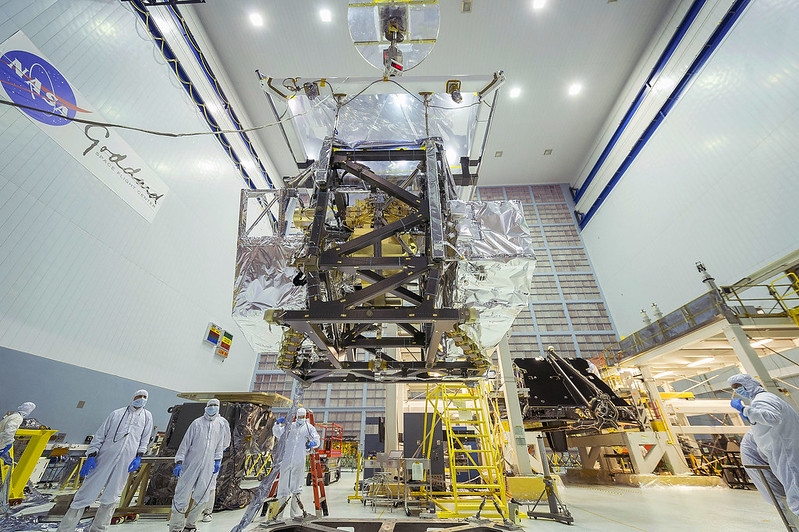
20 Years of Costs Add Up
At the outset, cost was not the biggest concern for NASA and its partners, Geithner said. Program managers considered certain tradeoffs and costs at an abstract level, but when you’re inventing new technology, there’s no way to know for sure.
“You can take wild guesses on the cost using cost models of prior spacecraft that use similar parameters, like mass and size of optics,” Geithner said. “But with something like this, which is so beyond anything that has been done before, those models don’t have a whole lot of relevance. You use them to take a guess, but you really don’t know how much the real flight articles are going to cost.”
So after two-plus decades of technology exploration, development, and international collaboration, how do you ensure that every stakeholder’s time and money are being appropriately used and respected?
For starters, by not making hasty decisions. Geithner said that the initial technology investigation phase, when NASA was funding research into various technologies that may develop into viable products for flight, lasted 10-15 years. “There’s a feedback loop in the early phase,” Geithner said, where the responsibility for how and when to move forward with technology development bounces back and forth between scientists investigating possible routes and decision-makers who decide what’s financially feasible and makes sense within the telescope’s time, mass, and compatibility constraints.
There were also tradeoffs from the beginning when deciding how instrument development, costs, and observation time on the telescope would be divvied up. The ESA, for example, wanted 15% minimum of total observation time. NASA, Geithner explained, decided that was a fair trade in exchange for ESA supplying two instruments and launch services. At the time, an Ariane rocket was one of the only viable rockets with a good track record that the agencies could trust to lift JWST out of the Earth’s atmosphere.
“There’s an exchange,” Geithner said. “If you want this much guaranteed during the ops phase, then you’ve got to chip in something comparable during the development phase. That was the philosophy.”
The same give-and-take applied to instrument development. With NIRSpec, for example, the ESA was responsible for building the instrument itself, but the detectors and programmable microshutter array were being developed by the Goddard Space Flight Center. So, Geithner said, those were the more important deadlines to meet. “You don’t want to cause each other costs. Because if they wait for us, their cash register’s running and [vice-versa] if we’re waiting for them…That’s what the partnerships are. It’s an extra management challenge.”
That said, the budget overruns and development extensions on JWST were significant. The project came under criticism many times over the last two decades. Cost estimates from a 2010 report criticized project leadership for grossly understating the project cost, and raised the total cost estimate from ~$5–$6.5 billion, still far short of the $10 billion reality. And back then, NASA still hoped the telescope would launch in 2014. As we now know, it took until Christmas day of 2021 to get JWST off the ground and en route to its destination one million miles away, and until the end of January to reach that final orbit.
In the end, it was the scientific capabilities and completeness of the telescope, not its cost or development length, that determined when JWST would launch. And with all of the science that the telescope will allow us to discover—“unlocking the secrets of the universe,” as the NASA tagline goes—we’ll leave it to readers to decide whether it was worth it.
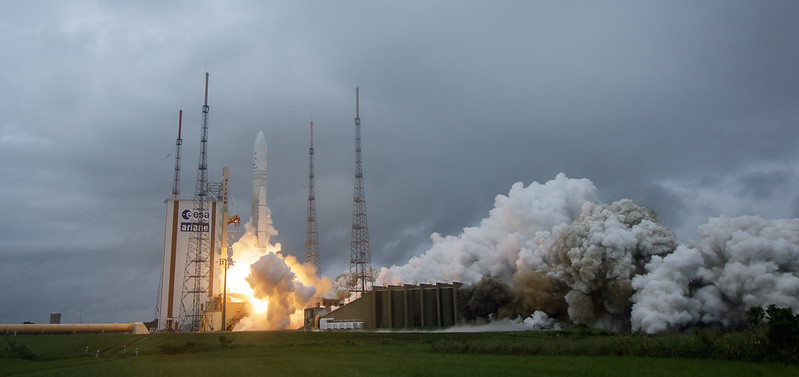
What lies ahead?
There are still a few months left before all the instruments on JWST are fully operational and ready to do their science homework. The 18 primary mirror segments still need to be perfectly aligned to act as one mirror. Those alignments will last through April.
The instruments themselves are turned on but are still in the process of cooling down to their optimal performance temperatures. Over the next few months, engineers one million miles away will be testing the instruments, checking all the settings, and making sure everything is aligned, calibrated, and working to perfection.
Then, in late June or July, NASA and its partner agencies will finally release the first images from the telescope. We don’t know about you, but we’re waiting with bated breath.
